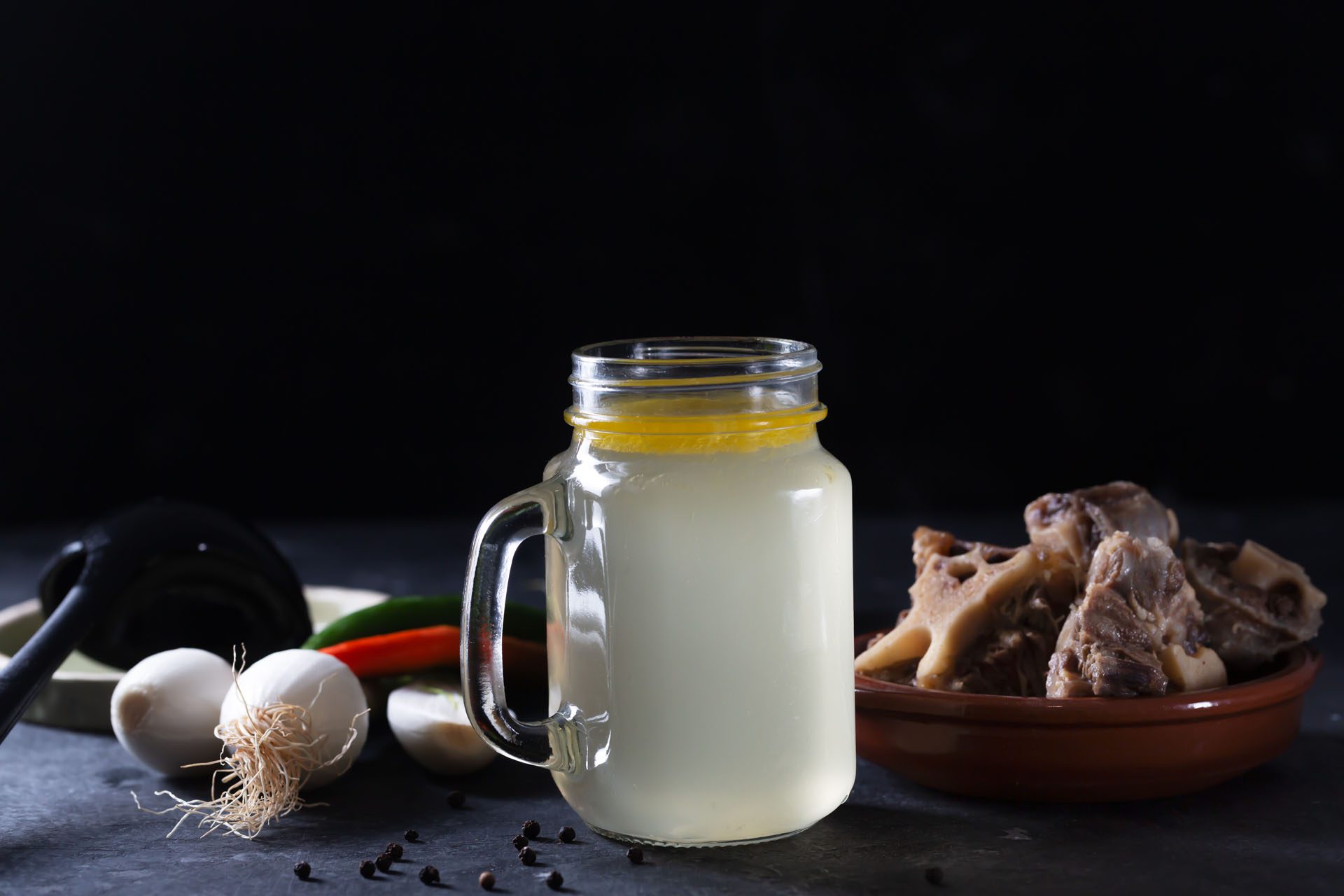Bone Broth Health: Benefits for Your Body
Can bone broth help individuals with gut issues or chronic conditions like inflammatory bowel disorder?

Bone Broth Health
Bone broth is a nutrient-rich beverage made by simmering animal bones, typically from beef, chicken, or fish, in water for an extended period (24-72 hours). It can be used as a beverage or as a base for soups, stews, and sauces.
Process
- Bones are roasted or boiled to release flavor.
- Bones are placed in a pot with water, vegetables (such as onions, carrots, and celery), herbs (such as parsley and thyme), and spices.
- The mixture is simmered over low heat for a long time, allowing the bones to release their nutrients and collagen.
- The broth is strained to remove the bones and solids.
Nutrients
Bone broth is a healthy source of:
Collagen
- A protein that supports skin, hair, and joint health.
Minerals
- Including calcium, magnesium, phosphorus, and silicon.
Amino acids
- Essential for building and repairing tissues.
Bone Broth Health Benefits
While there is limited research on the health benefits, the nutrients in bone broth can be beneficial for:
- Joint health
- Bone density
- Digestion
- Gut health
- Muscle growth and recovery
- Hydration
- Reduce inflammation
- Improve skin elasticity and appearance
- Boost immune system
While research on bone broth’s benefits is still limited, it’s a nutritious and hydrating beverage that supports gut health and recovery after a tough workout. It can be drunk on its own or used in cooking. Bone broth is a delicious way to replenish electrolytes and stay hydrated, whether recovering from a flare-up or an intense workout. It is especially helpful for those dealing with gut issues or chronic conditions like inflammatory bowel disorder.
Nutrient-Rich
- Bone broth is rich in minerals, including calcium, magnesium, potassium, phosphorus, and iodine.
Joint Health
- Collagen is the main source of protein found in bones, tendons, and ligaments.
- Research suggests that collagen may support joint health, protect the tissues in joints, and improve symptoms of osteoarthritis. (Martínez-Puig D. et al., 2023)
Anti-Inflammatory
- Bone broth contains glycine and arginine, amino acids with anti-inflammatory properties.
- These amino acids also help the body produce more collagen. (Chen, S. et al., 2010) (Razak M. A. et al., 2017)
Protein-Rich
- Incorporating bone broth into one’s diet can help meet protein goals.
- One cup of bone broth contains four to 20 grams of protein.
Digestion and Gut Health
- Colostrum is the first milk produced after giving birth, and some research suggests this may offer immune-boosting benefits and gut repair, but more research is needed. (Playford R. J., & Weiser M. J. 2021)
- Bone broth contains glutamine, an amino acid that can reduce inflammation in the gut, strengthen the gut lining, and maintain a healthy microbiome.
- It also contains glycine, which may help quell digestive issues such as acid reflux or GERD, though research is limited. (Wang B. et al., 2015) (Nagahama K. et al., 2012)
Many bone broths are high in sodium and may not be suitable for individuals on low-sodium diets. It is recommended to consume less than 2,300 milligrams of sodium per day to support a healthy heart, reduce the risk of high blood pressure, look for other sources of sodium, and incorporate bone broth accordingly. (American Heart Association, 2024) Also, because of the polysaccharides that may leach from the cartilage and the garlic and onions usually present in the bone broth, it’s not suitable for those with a digestive disorder like small intestinal bacterial overgrowth (SIBO) or individuals following a low-FODMAP diet.
What To Look For
Quality
- When possible, choose a bone broth that’s grass-fed and organic.
- Quality matters because the process of simmering the bones with water pulls all the nutrients, collagen, and protein into the broth.
- Starting with the highest quality ingredients ensures it will be as nutritious as possible.
Type
- Various types include chicken, beef, turkey, and bison varieties.
Packaging
- Bone broth comes in various packaging, including shelf-stable, frozen, or fresh.
- When selecting, consider how often it is used, how much is needed, and storage space.
- For individuals who drink bone broth daily, buying it in bulk and storing it in the pantry or freezer may be more budget-friendly.
Consistency
- Generally, bone broth is a thick, slightly viscous beverage.
- Individuals who prefer a thinner liquid should try a shelf-stable broth, which is usually less gelatinous than frozen bone broths.
- Powdered bone broth is also a great option for those who prefer a lighter beverage.
- Individuals can choose a low-sodium bone broth to limit sodium intake.
Injury Medical Chiropractic and Functional Medicine Clinic
Injury Medical Chiropractic and Functional Medicine Clinic works with primary healthcare providers and specialists to develop highly effective treatment plans through an integrated approach for each patient and restore health and function to the body through nutrition and wellness, functional medicine, acupuncture, Electroacupuncture, and integrated medicine protocols. We focus on what works for you to relieve pain, restore function, prevent injury, and mitigate issues through adjustments that help the body realign itself. The clinic can also work with other medical professionals to integrate a treatment plan to resolve musculoskeletal problems.
Reducing Inflammation In The Body
References
Martínez-Puig, D., Costa-Larrión, E., Rubio-Rodríguez, N., & Gálvez-Martín, P. (2023). Collagen Supplementation for Joint Health: The Link between Composition and Scientific Knowledge. Nutrients, 15(6), 1332. https://doi.org/10.3390/nu15061332
Chen, S., Kim, W., Henning, S. M., Carpenter, C. L., & Li, Z. (2010). Arginine and antioxidant supplement on performance in elderly male cyclists: a randomized controlled trial. Journal of the International Society of Sports Nutrition, 7, 13. https://doi.org/10.1186/1550-2783-7-13
Razak, M. A., Begum, P. S., Viswanath, B., & Rajagopal, S. (2017). Multifarious Beneficial Effect of Nonessential Amino Acid, Glycine: A Review. Oxidative medicine and cellular longevity, 2017, 1716701. https://doi.org/10.1155/2017/1716701
Playford, R. J., & Weiser, M. J. (2021). Bovine Colostrum: Its Constituents and Uses. Nutrients, 13(1), 265. https://doi.org/10.3390/nu13010265
Wang, B., Wu, G., Zhou, Z., Dai, Z., Sun, Y., Ji, Y., Li, W., Wang, W., Liu, C., Han, F., & Wu, Z. (2015). Glutamine and intestinal barrier function. Amino acids, 47(10), 2143–2154. https://doi.org/10.1007/s00726-014-1773-4
Nagahama, K., Nishio, H., Yamato, M., & Takeuchi, K. (2012). Orally administered L-arginine and glycine are highly effective against acid reflux esophagitis in rats. Medical science monitor: international medical journal of experimental and clinical research, 18(1), BR9–BR15. https://doi.org/10.12659/msm.882190
American Heart Association. Association, A. H. (2024). Lifestyle & Risk Reduction, High Blood Pressure. https://www.heart.org/-/media/files/health-topics/answers-by-heart/why-should-i-limit-sodium.pdf

